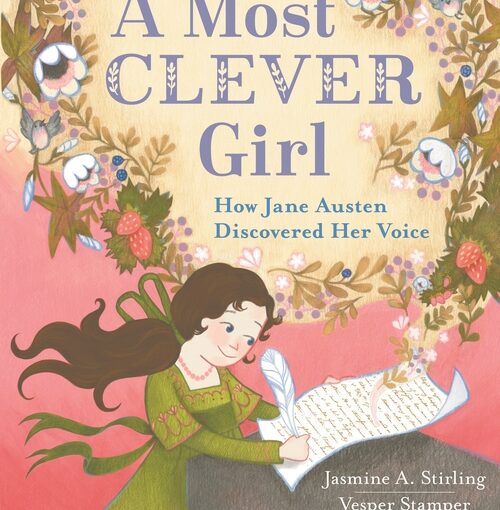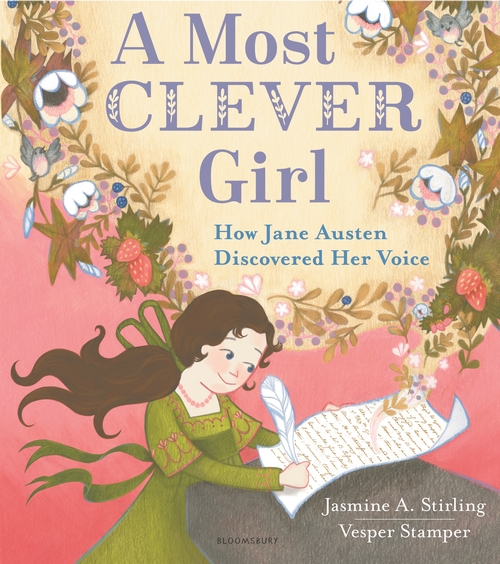There are books that kids want to read and those others that parents or educators want them to read. A Most Clever Girl, How Jane Austen Discovered Her Voice is a fascinating illustrated book because it straddles the line between the two very well. Jane Austen’s books are the stuff that high school students dread reading. Sure they are classic books, lauded by teachers, and have two centuries of weight behind them. However, her books have very little relevance to most casual readers and those tween readers that are forced to read them. On the contrary, A Most Clever Girl, How Jane Austen Discovered Her Voice is a fun book that shows younger readers how entertaining and (gasp) fun her books are, especially when viewed through the prism of 1800.
The combination of illustration and text is just perfect in this book. The art by Vesper Stamper and text by Jasmine A. Stirling parry and thrust each other in a friendly way that those really great illustrated books do. It’s a non-fiction illustrated book that tells an interesting story that has a beginning, middle, end and allows those curious older readers to learn more about the titular character through Austen’s literature.
For most readers, the surprising takeaway is that it manages to make the late 1700s in England seem like an entertaining and fun time. Granted, it may have a chirping-merry grand time of a hootenanny, but those simpler times can as easily be associated with Scarlet Fever, as well as, Bridgerton, even though the latter is more fun to read or watch. Cottagecore fans and those that enjoy a nice illustrated book unite because this book fits the bill for both.
For example, when we see a young Austen laying on the floor laughing as she’s reading we discover that she’s laughing because most of the books written during her formative years were schmaltzy. They were cheesy fluff with princesses in predictable situations, orphans on doorsteps, or women who fainted too often. She started writing silly stories that swam in ridiculous waters. Her family would gather around as she read them aloud.
One particular story was about two children who were so hungry that they bit off their mother’s fingers. Jane Austen was not the Jigsaw of the late 1700s. This was a funny tale that left her family in stitches, as opposed to the movies which required them to keep their plots and characters together.
And what a family Austen had. She had seven siblings, two parents, a couple of servants, and some of the students that her father taught, all living in the same house. It was a large house in the country where they learned, lived, and noticed how their neighbors lived up to the silly stereotypes that Jane made fun of in her early stories.
In that time women were not given the opportunity to write or create things. Their path was already laid out by society and their families. Her dad was different though because he educated her to a very high level and saved up money to buy some nice paper and writing instruments. Alas, the years of cottagecore came to an end for the Austen family when her dad stopped teaching and money became scarce.
They had to move from the country to the city. It was an entirely new pallet of characters for Jane to observe, but she didn’t feel the motivation to continue telling stories. However, time heals all, she got over her father’s death and rediscovered the joys of writing. She went back to some of the stories she wrote when she was younger, modeled them after the happiness that her family used, and recreated that world. It turns out that people loved the books. Their irreverence, humor, and snappy dialogue caught the attention of everyone, even the future king of England, George IV. So it turns out Jane Austen was more Aaron Sorkin than Jigsaw, a fact that readers and educators around the world can be thankful for.
A Most Clever Girl How Jane Austen Discovered Her Voice is by Jasmine A. Stirling with illustrations by Vesper Stamper and on Bloomsbury Children’s Books.
There are affiliate links in this post.






 Facebook
Facebook Twitter
Twitter Flickr
Flickr GooglePlus
GooglePlus Youtube
Youtube